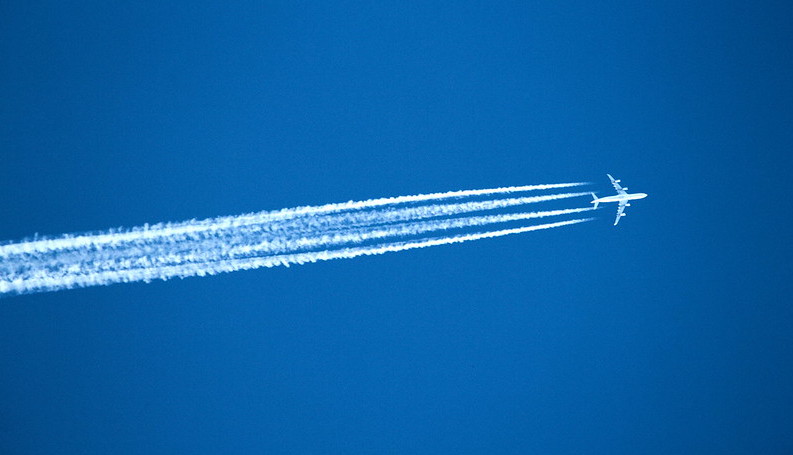Mass groundings of flights caused by the coronavirus are giving scientists a rare chance to study plane-free skies and pin down how far aviation stokes global warming.
In response to the Covid-19 pandemic, air traffic has slumped in a manner not seen since the aftermath of the 9/11 attacks on the United States in 2001.
Scientists with Nasa and European research groups hope to use clear skies to narrow down massive uncertainties about the warming effect of condensation trails – the wispy white lines that criss-cross the skies in the wake of jets engines.
Understanding planes’ impact on the climate is urgent because commercial aviation generates about 2% of global carbon emissions and rising, mainly from burning jet fuel. Taking into account the impact of cloud formation in the upper atmosphere, however, could make the sector’s responsibility for human-caused global warming as high as 4% or 5%.
“It is welcome that we can have an experiment with the Earth,” said Ulrike Burkhardt, of the Institute of Atmospheric Physics at the German Aerospace Center (DLR). “But it’s not the way we would want to design it.”
Coronavirus has killed almost 90,000 people. Global demand for air travel is down 70% compared to last year and millions of jobs are at risk, according to the International Air Transport Association (Iata), which represents airlines.
Researchers will use satellites and measurements by planes to study how clouds form naturally when thousands of flights are grounded, and contrast it with data from pre-coronavirus conditions of crowded skies. In the long term, that could help governments set better policies.
Airlines urge UN body to ease climate goals for 2020s as traffic collapses
Under social distancing guidance to prevent the spread of Covid-19, however, Burkhardt said it was difficult to assemble teams of technicians to install sensors on planes and find pilots to fly them.
“The air traffic system has not been diminished to the current levels since the days following 9/11,” said Patrick Minnis of Nasa Langley Research Center, who is joining a research effort to study high-altitude clouds.
“Flight groundings at the scales initiated in response to the coronavirus pandemic are a significant opportunity to better quantify the impact of air traffic on cloud cover via contrail formation.”
The new research builds on studies after the 9/11 suicide hijackings in the US grounded flights for a few days. One study, for instance, found that the plane-free skies had an impact on temperature variations in the United States, but some researchers say the findings might have been caused by natural variations.
Minnis and colleagues are trying to determine whether contrails increase the total amount of clouds in the sky, or suck up moisture that might have allowed clouds to form elsewhere. That would help to establish whether contrails and cloudiness linked to aviation had an overall warming or cooling effect on the planet.
Most low clouds such as cumulus are made up of tiny water droplets and reflect sunlight back into space from their white tops. That helps to keep the planet cool.
By contrast, icy, high-altitude clouds formed by contrails have an overall warming effect because they trap more heat escaping from the Earth’s surface than they reflect back into space.
Coronavirus lockdown gives a boost to citizen science projects
Contrails typically form at 8-13 kms above the Earth, depending on factors including temperature and moisture. They are less likely in tropical regions than the higher latitudes of Beijing, New York or London.
Between 2013 and 2019, aviation sector emissions grew from 733 million tonnes to 915 million tonnes of CO2, according to Iata.
Piers Forster, professor of Physical Climate Change at the University of Leeds, said that the “total historic warming from aviation is roughly twice that from its carbon dioxide emissions alone”.
“The total warming effect of aviation is still small: maybe 5% of the warming from all human activity,” Forster said, factoring in cloud formation. “But as other emissions will hopefully decline, it is expected that aviation will be the dominant source of emissions within the next few decades…
“We are beginning to look at this. We are looking at contrails and general high level cloudiness changes” amid coronavirus, he said.
Airlines urge UN body to ease climate goals for 2020s as traffic collapses
Nations have agreed to offset the growth in carbon dioxide emissions from 2020 under the International Civil Aviation Organization (Icao). So far, there is no consensus to curb the overall warming effect, partly because the impact on cloud formation is too uncertain.
At an individual level, flying is one of the most climate polluting activities a person can undertake. Swedish teen climate activist Greta Thunberg has famously refused to fly, sparking a debate about the morality of air travel. There are some signs “flight shame” is dampening demand in wealthy parts of the world.
But Bernd Kärcher, a colleague of Burkhardt at Germany’s DLR, said the 2020 slowdown was likely to be short-lived, in a long-term trend of more flights. He estimated that aviation contributed 4% to man-made global warming, with most of it from contrails rather than carbon dioxide and other greenhouse gases.
Understanding all impacts of aviation was vital to the policy response, Kärcher said: “To meet the Paris climate goals, every tenth of a degree of reduced increase in surface temperatures matters.”
The plane-free skies could help narrow uncertainties and so help guide longer term policies, he added. “Icao points to the need for scientific consensus, which, so it is argued, is absent in the case of non-CO2 cloud effects.”
He said that other ways to reduce non-Co2 effects could be cleaner fuels that produce fewer contrails, re-routing flights to regions or altitudes where contrails are less likely to form, or better aircraft design.
